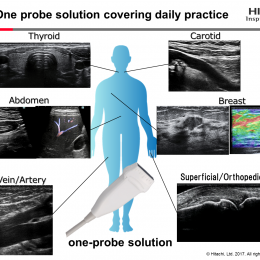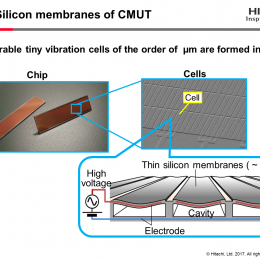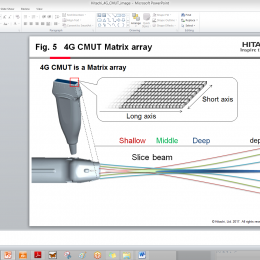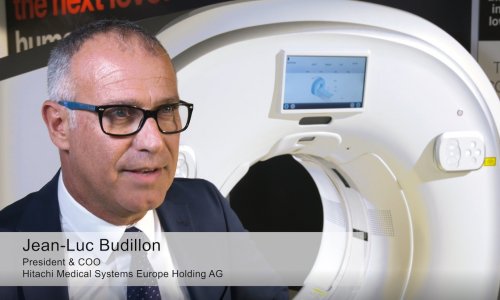Sponsored • Transducer
The multi-tasking 4G CMUT linear matrix probe
Holding Hitachi’s newest ultrasound probe in your hand, it looks and feels like any other ultrasound transducer. ‘Yet, you are actually holding a marvel of ultrasound engineering, a true break-through in transducer architecture that performs so well across so many types of exams that you may never want to let it go,’ the manufacturer reports.
Hitachi’s next generation linear matrix transducer is the first and only commercially available in daily practice, Capacitive Micro-machined Ultrasound Transducer (CMUT), a technology so advanced that the inventors at the prestigious Stanford University in Palo Alto, California could take it no further than a prototype. After more than 12 years’ work, the engineers at the Hitachi Ultrasound Research & Development Centre, in Tokyo, overcame the technical challenges to bring this innovative probe into daily practice.
No switch from high to low frequency sessions
‘The most important thing about this new transducer is that clinicians no longer need to switch probes between high frequency and low frequency sessions,’ said Hiroki Tanaka, one of the lead developers. ‘Physicians can now use Hitachi’s 4G CMUT for superficial examinations of the breast, for example, by applying a high frequency; then with this same probe, they can perform low frequency exams of the abdomen, liver or pancreas, for example. With this one probe, they can cover almost all applications in daily routine.’
Introduced at the 2017 European Congress of Radiology, the Hitachi 4G CMUT is actually the fourth generation of this technology, he pointed out.
Hitachi released the first-ever CMUT in 2009, which could generate excellent B-mode images using low power, but which limited its application primarily to breast exams. The next generation offered an increased bandwidth, enabling higher two-dimensional quality with Tissue Harmonic Imaging and an increased sensitivity for Doppler and Colour Doppler to image blood flow. The new linear matrix probe expands even further the bandwidth capacity to a range from 22 MHz down to 2 MHz, the low frequency needed to examine deeper structures in the human body.
All on a single wafer

Open up any other ultrasound transducer and you will find hard ceramic crystals that have been hard-wired to generate and receive sound waves. Inside the CMUT you will find a soft membrane embedded with electrodes that vibrate to transmit an ultrasound signal. The break-through with 4G CMUT is the micro-machined architecture on a silicon wafer. The membrane is less than three microns thick and behind this is a cavity of just 100 nanometres. The transducer array is constructed by combining a large number of these CMUT cells. ‘The CMUT membrane is very close to the human body for its softness, so the ultrasound pulses smoothly from the probe and through the human body,’ Tanaka explained. ‘This architecture is more direct and precise with no deflection using very short pulses with no refraction wave. Because it transmits broadband, all frequencies are sending pure signals and nothing gets lost.’
Hitachi engineers also solved the problem of applying high power levels to the CMUT cell, an achievement that has created a stir in the engineering community and has further enhanced the reputation of Hitachi as the most innovative developer in the field of ultrasound, the company points out. ‘Hitachi released the world’s first diagnostic ultrasound system in 1960, the world’s first real-time colour flow Doppler in 1983, and invented ultrasound elastography in 2003.’ With high-energy pulses, the 4G CMUT is able to generate higher amplitude signals, which allow Tissue Harmonic Imaging thanks to yet another Hitachi innovation for modulating the amplitude, the company adds. In addition, matrix array allows control of the short axis focus and to optimise the slice beam in any depth automatically to obtain the high image quality at wide range of depth.
The 4G CMUT is one of the leading features of the ARIETTA 850, the premium ultrasound platform also introduced at ECR 2017. Combined with eFocusing, a dynamic transmission and reception technology, and a 22-inch wide Organic Light Emitting Diode (OLED) monitor the Arietta 850 maximises the performance of wide bandwidth 4G CMUT and opens the door to the next stage in ultrasound.
Source: Hitachi
24.08.2017
















